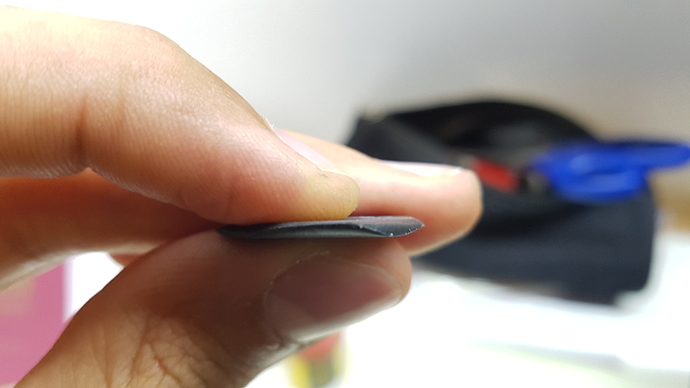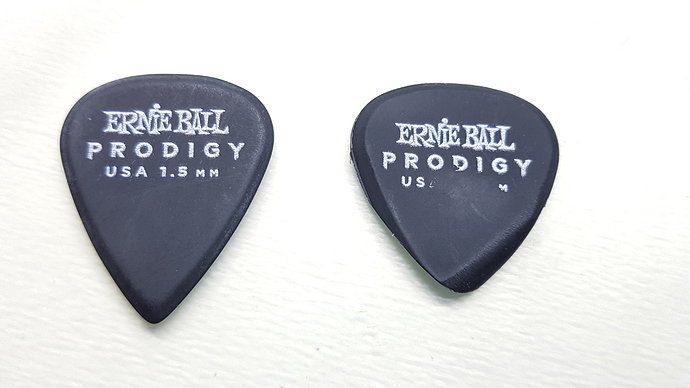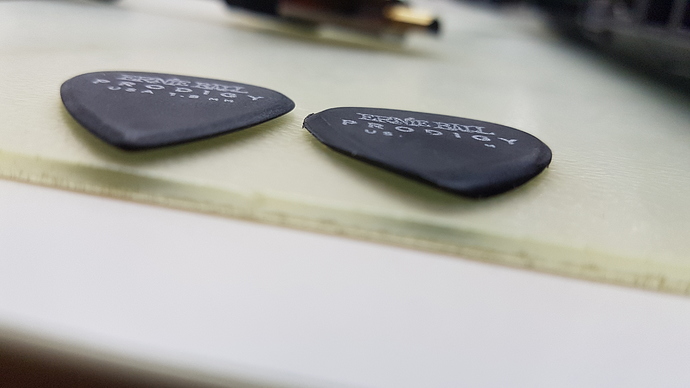Blue Chip picks essentially don’t wear out. They also provide the smoothest surface, with the least scratchy tones. I also have experimented with light polishing or sanding with very fine grit of regular picks when the edge gets sharp and the tone thins out. It works, if you can be bothered!
It would be interesting to see if the videos can capture different tone production. There is a huge difference in sounds you can get by the way you hold the pick and the motion mechanic, especially on acoustic guitar. With all this technology going toward improving speed and accuracy, how about a “look” at tone?
That is indeed what this section is about. It’s the “how” of how picks work. We do lots of comparisons, with frequency analysis, to understand how picks succeed in playing notes at all, and what does and does not make them sound the way they do. It isn’t even so much discovery of unknown stuff but more like an attempt to take what experienced players already know, put some numbers behind it, and present it in a way that is at least entertaining for beginners and experienced players alike.
Incidentally, is there any plan to do a similar analysis for string gauges? Seems to be a pretty big part of the proverbial equation.
Thanks Troy, I look forward to this series!
Just got through watching the new “Pick Design and Function” chapters, and the frequency response curves in the various comparisons were neat. Thing I found most interesting was the abrasion chapter. Might have to grab some of those Ibanez Elastomer picks to experiment with. And glad to see the Buck Rogers themesong make another appearance. 
Why the abrasion chapter?
I’ve noticed the difference in feel between abraded and non-abraded nylon picks (I mostly use the black stiffo Jazz III XL, and I tend to use a single pick for a long, long time). But I had never noticed (and it never occured to me) that there might be a significant difference in frequency response between an abraded and non-abraded pick. And the chirp discussion helped me better understand why I dislike the sound of thick Ultex picks (though I don’t mind the Ultex Sharp 1mm).
And I thought it was interesting that abrasion can result in a bump in high frequency overtones in an otherwise “dark” pickstroke (the “dark sparkle”, which BTW sounds like a great name for a “My Little Pony” villian.)
Ok we went with the abrasion chapter for the public YouTubeses:
The title is a little dramatic but the truth is, before I knew anything about picks or really even thought much about them, abrasion was probably the one characteristic of pick construction I remember that did matter. Once the Nylons got too scratchy, it was like getting sand in your shoe at the beach. As long the annoyance was at least evenly distributed, you could keep playing the pick. But if a big chunk goes missing, that’s like a rock in your shoe and then it was time to retire the pick.
@Troy Hi from Italy! Yesterday I saw your last video on youtube about picks abrasion and I found it really interesting. Now I’d like to share with you an experiment I did some months ago.
I bought the Ernie Ball Prodigy picks 1.5 mm and I didn’t find them confomrtable for my plating because of their sharp extremity even if I like the fact that they don’t consume. So I used a nail file to make some adjustements (see photo).
The first thing I noticed was that there was no friction between the pick and the strings at all, every pick stroke was effortless. I find this very positive but on the other hand this exaggereated filing eliminated all the high frequencies of the pick stroke and forced you to play with an obliged angle of 45°. I play metal so this is not a problem for me and I can get the high frequencies with the distortion, but for other styles or using a clean channel this may be unfavourable, or maybe you can find a very warm tone for slow and atmospheric arpeggios, it’s up to you!
Cheers
Hi Troy, long time no contact 
While enjoying the video series on all things picks I couldn’t help but notice that you are mentioning a couple of times that you are not sure about the exact physics and science behind some of the tonal effects. If you are interested in digging a bit deeper on that aspect I can very much recommend a guy named Manfred Zollner. He is one crazy german professor who spent most of his spare time the last 15-some years in the lab figuring out what exactly the physics behind electric guitars (and strings, pickups, amps, speakers, mics, …) are . His results are captured in a series of books. “Physik der Elektogitarre” consisting of 3 volumes that add up to thousands of pages of deep scientific stuff on these topics. Awesome! At this time I believe the books are still not translated to English, which is a shame, but he is also running the Gitec Forum website (https://gitec-forum.de/wp/en/) that offers translations for some articles and chapters. Anyways, I know this guy and I’m sure he’ll be glad to provide his scientific insight on any questions you might have.
Cheers,
Holger
I think a download of the version of the Buck Rogers theme song is called for. Troy’s arragement (especially the guitar tones) is AWESOME!!!
Here’s a Soundcloud link. Full mix, backing, and lead/strings/synth. I don’t think we have built any song download capability for the actual platform, ironically enough. We’ll put that on the to-do list.
Edit: Threw in some Marty Friedman / Li-Sa-X Speed Racer. Always liked that one.
These are friggin’ AWESOME!!! I’m loving every lesson here on CTC, but at some point, Troy, please share your music production and engineering process for getting your guitar tones and stuff!!
We do have a couple things along these lines, behind the scenes from a while back about the production of some Cracking the Code original soundtrack…I think you’ll enjoy if you haven’t seen these yet!
Duh. Forgot about those!



